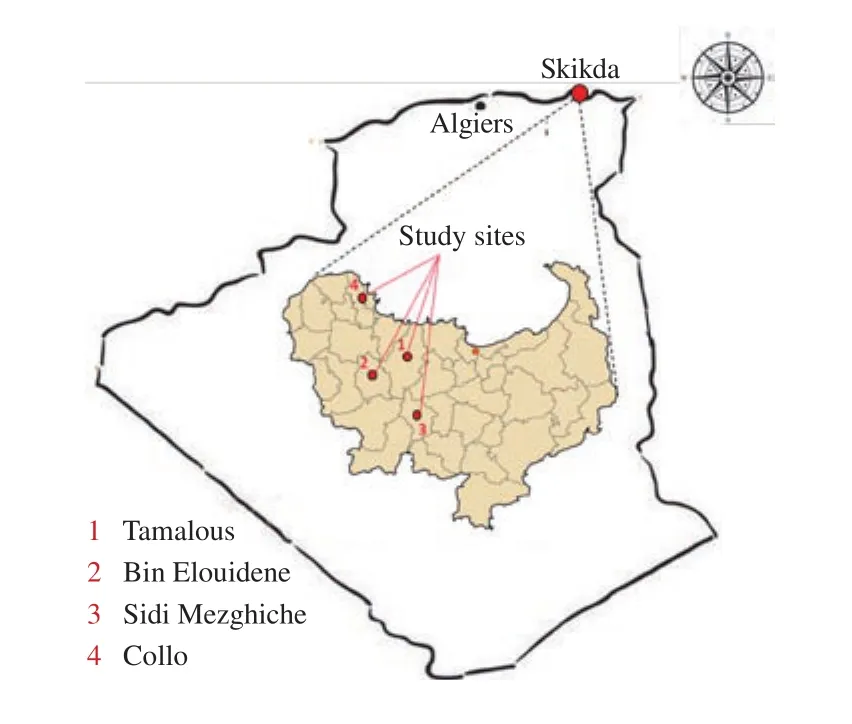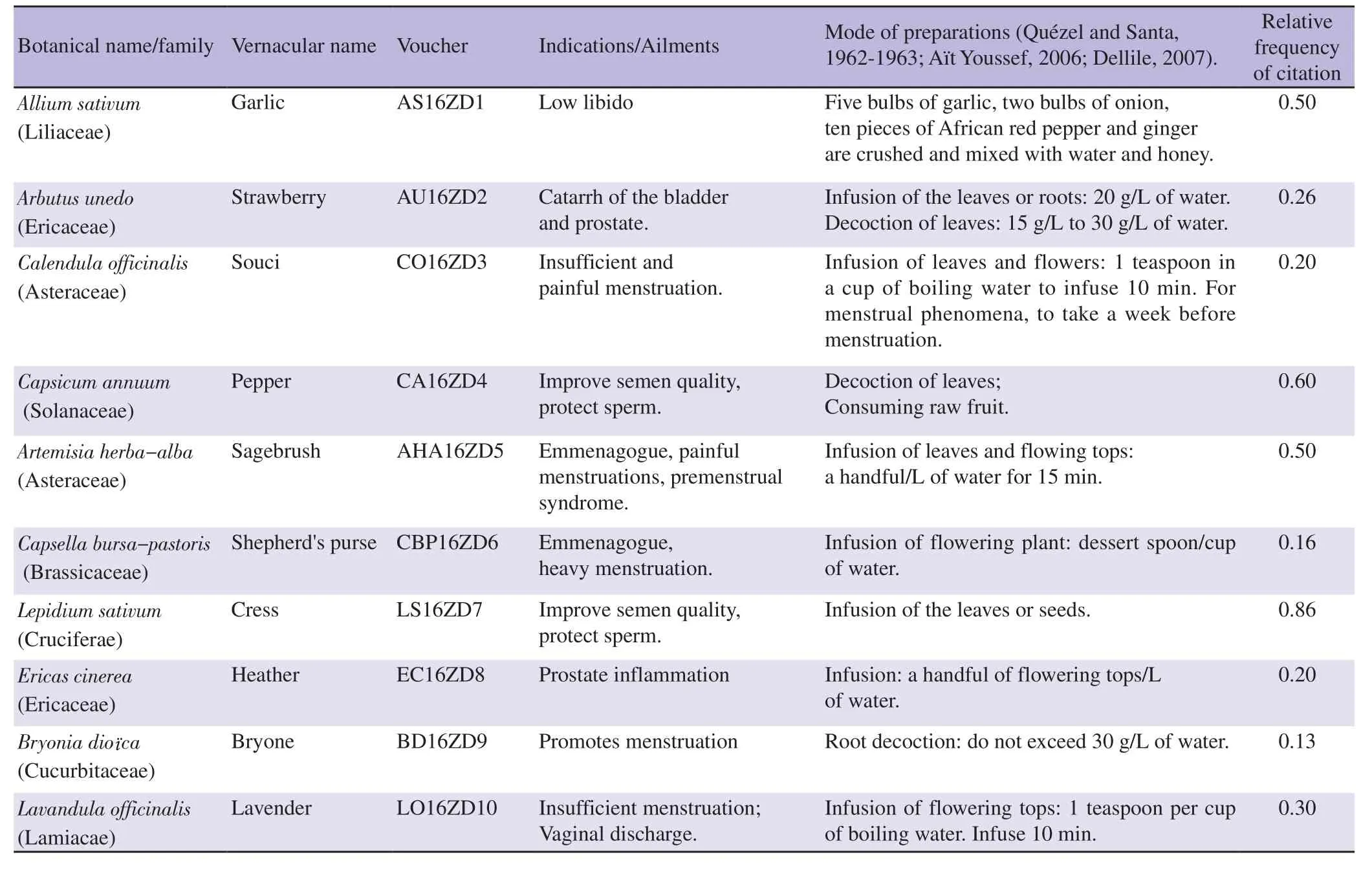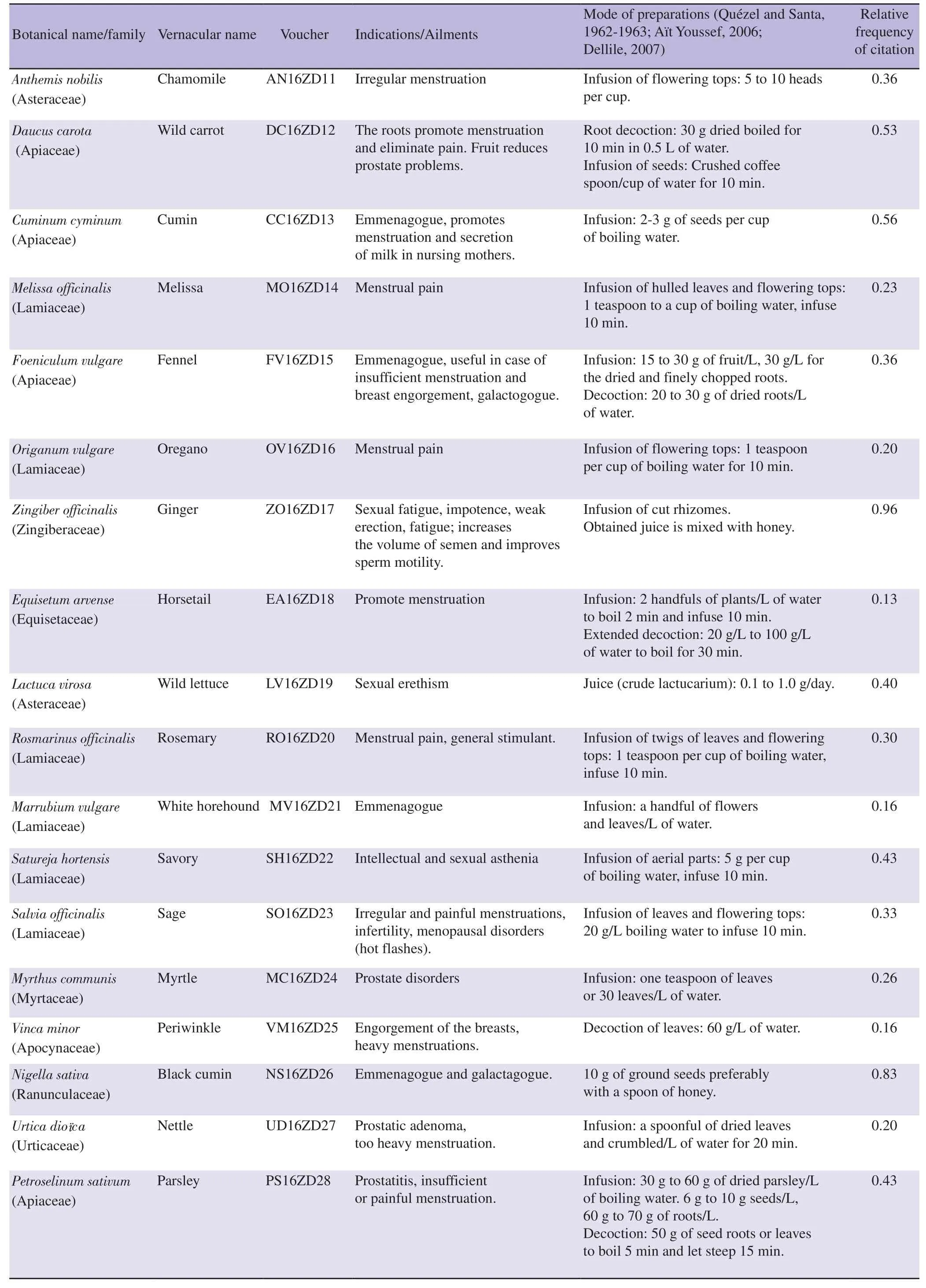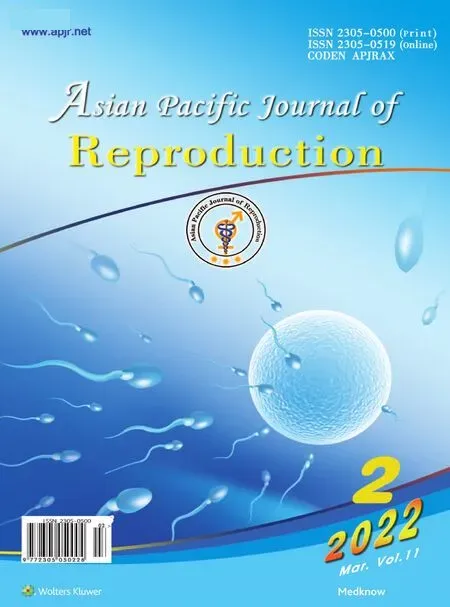An ethnopharmacological survey of medicinal plants used in the traditional treatment of human infertility in eastern Algeria
Zouhir Djerrou,Houria Benyezzar-Kenana,Zineb Maameri,Louiza Benhamza
1Department of Sciences of Nature and Life,Faculty of Sciences,University of 20 Ao?t1955- Skikda,Algeria
2Laboratory of Pharmacology and Toxicology,Institute of Veterinary Sciences,University of Mentouri Constantine,Algeria
3GSPA Research Laboratory,Institute of Veterinary Sciences,University of Mentouri Constantine,Algeria
ABSTRACT
Objective:To summarize medicinal plants used in the treatment of couple fertility disorders.
Methods:An ethnopharmacological survey was conducted with 30 traditional healers from some localities of Skikda region in eastern Algeria. A standard questionnaire was used in the interview which focused mainly:the treated fertility disorders,the used medicinal plants species,parts used,and preparation methods. The relative frequency of citation and percentages of infertility troubles were calculated and analyzed.
Results:The most important treated disorders in men were dysfunction of libido (44.22%),low sperm concentration and motility (25.33%),low semen volume (17.67%) and prostate disorders (5.66%). Women were treated mainly for menstruation disorders (35.32%),breast problems (29.53%) and sexual asthenia(25.82%). The survey identified 28 plant species belonging to 15 families,used by different ethnic groups,particularly women(58.00%),to address different fertility disorders. Three plant families were largely used viz Lamiaceae,Asteraceae,and Apiaceae.In term of relative frequency citation,ten dominated plant species were:Zingiber officinalis L. (0.96),Nigella sativa L. (0.83),Lepidium sativum L. (0.80),Capsicum annuum L. (0.60),Cuminum cyminum L. (0.56),Origanum vulgare L. (0.55),Allium sativum L. (0.50),Petroselinum sativum L. (0.43),Salvia officinalis L. (0.42),and Foeniculum vulgare L. (0.40). A number of investigated plants were scientifically confirmed by phytochemical and pharmacological studies to have one or more significant effects on couple fertility.However,much controversy was found in literature concerning the efficacy of some cited plants.
Conclusions:The study highlights the important use of medicinal plants in management of couple infertility in eastern Algeria. More experimental studies are recommended to confirm or to refute these traditional uses and to ascertain the safety of these medicinal plants to consumers.
KEYWORDS:Algeria; Ethnopharmacological survey;Infertility; Medicinal plants; Men; Sterility; Traditional medicine;Women
Significance
Fertility is a health issue of concern to both male and female couples. The current survey conducted in Skikda region has shown that treated disorders in men were mainly dysfunction of libido (44.22%),low sperm concentration and motility(25.33%),and low semen volume (17.67%). Women were treated mainly for menstruation disorders (35.32%),breast problems (29.53%) and sexual asthenia (25.82%). Twentyeight plants species belonging to 15 families were used in the treatment of couple fertility disorders in eastern Algeria.
1. Introduction
Infertility is defined as the inability of a couple to have a pregnancy,after regular sexual intercourse for one year without contraceptive method[1]. It is a worldwide medical and social problem causing a possible serious impact on the mental and social well-being of infertile couples. According to the World Health Organization,10%–15% of married couples are affected from infertility problem,which often leads to marital disharmony,divorce or ostracism[2]. In a couple,infertility can come from men (35% of cases),women (40% of cases),both of them (15% of cases) or of unknown causes (5% of cases)[3]. Psychological distress,and behavioral effects associated with lifestyle decisions may also affect fertility[4-6]. According to Hull et al[7],the cause of infertility sometimes is uncertain and is referred to as “unexplained infertility”in approximately 25% of couples.
Infertility in women can occur from ovulation failure,tubal infective damage,endometriosis,cervical mucus defects or dysfunction,and uterine abnormalities[7,8]. It is estimated that 10% to 15% of adult females are affected by a complex endocrine disorder,polycystic ovary syndrome[9,10]. It is estimated that 40% to 90% of male infertility occurs due to deficient sperm production of indefinable origin[11]; the main troubles encountered are:azoospermia,oligozoospermia,teratozoospermia and athenozoospermia[12]. Whatever,the cause of male reproductive dysfunction,whether it is varicocele,cancer or cryptorchidism,the semen analysis remains today the gold standard for diagnosis of male infetility[13].
Many studies have indicated the implication of secondary metabolites from medicinal plants in the treatment of the human reproductive system related with infertility[14]. The number of couples using medicinal plants alone or in combination with conventional drugs to promote fertility is increasing in different countries and cultures. In this context,the current study was undertaken to inventory the medicinal plants used in the traditional management of human infertility in eastern Algeria.
2. Material and methods
2.1. Study area
The current ethnopharmacological survey was carried out in Skikda region which was chosen because of the richness of its mountains in medicinal plants,and the important use of medicinal plants by the local population in this region. Sikka is located in north-eastern Algeria (Figure 1); the chief place of this wilaya is located 510 km to the west of the capital,Algiers. The Mediterranean climate,with hot summer climate,is the principal of this province. Skikda is situated at 36.88° North latitude,6.91° East longitude and 34 meters elevation above the sea level. The coast of the province accounts for about 11% of the Algerian coastline[15,16].

Figure 1. Map of Algeria illustrating the localities subjected to the survey(Tamalous,Bin Elouidene,Sidi Mezghiche,and Collo).
2.2. Methodology
2.2.1. Selection of tradipractitioners
The ethnopharmacological survey was conducted in some regions of Skikda (Localities of Collo,Tamalous,Sidi Mezghiche,and Bin Elouidene) with 30 famous traditional healers to identify medicinal plants used as a complementary therapy in the treatment of infertility of female and male in these localities. The traditional healers interviewed were well experienced with good reputation. And they were able to identify the plants by themselves.
These regions are characterized by their rural aspects and by their mountains rich in medicinal plants. The demographic characteristics of interviewed persons are presented in Table 1.

Table 1. Demographic characteristics of interviewed tradipractitioners [n (%)].
2.2.2. Data collection
The survey was conducted during the period January 2015-November 2016. For the successful completion of this study,a literature review was associated with ethnopharmacological investigation[17-19]. A questionnaire form was prepared and used to guide the interview with tradipractitioners which focused on:type of fertility disorder treated,used medicinal plant’s species,used parts,and preparation method of these medicinal plants. The different plants cited were harvested (or bought) and were identified by botanical specialist (Dr. Messaoud Laib),and voucher specimens were deposited in the Herbarium of Department of Nature and Life Sciences,University of 20 Ao?t 1955-Skikda,Algeria.
2.2.3. Data analysis
The relative frequency of citation (RFC) was calculated[20]by dividing the citation frequency (FC) by respondents’ number (N) in the study according to the formula:RFC = FC/N. The RFC index ranges from “0” when nobody referred to a plant as useful to “1”when all informants referred to a plant as useful.
2.3. Ethics statement
This study was approved by the scientific committee of Department of Nature and Life Sciences,University of 20 Ao?t 1955-Skikda(SNV/03-01/15).
3. Results
3.1. Demographic characteristics
In general,96.67% (29/30) of interviewed population had 29 years old and above; this may be explained by the nature of this job which required more experience. The age group representing a majority was between 40 to 60 years (46.67%) (14/30). Only 6.67% interviewed tradipractitioners were female because this kind of activity was mainly exerted by men according to social traditions of these localities. The ethnic groups participated in this study covered the majority of ethnics of Skikda region,and 83.33% of them had a secondary school level (Table 1).
3.2. Ethnobotanical survey
3.2.1. Treated causes of infertility
According to respondents,they had treated more women (58.00%)than men (42.00%) for fertility disorders. Generally,men resorted to medicinal plants to remedy libido dysfunction (44.22%),low sperm volume (17.67%),low sperm concentration and mobility(25.33%) and prostate disorders (5.66%) of cases. Women solicited tradipractioners mainly for sexual asthenia (25.82%),menstruation troubles (35.32%) and related breast problems (29.53%) of cases. Sometimes,the couple used medicinal herbs for general strengthening effect,or when the cause of infertility was undefined.
3.2.2. Medicinal plants used against infertility
The ethnobotanical survey conducted in the above-mentioned localities allowed to inventory 28 plant species having therapeutic potential for the infertility disorders (Table 2). It should be mentioned that some plants were experiencing a restricted use by local population compared with other widely known species having better relative frequency of citation viz:ginger (0.96),Nigella (0.83),cress (0.80),pepper (0.60),cumin (0.56),oregano (0.55),and garlic(0.50).

Table 2. Medicinal plants used in the treatment of couple infertility.

Table 2. Continued.
Some of these herbs were used alone or in combination with others to potentiate the pharmacological activity or widen the range of desired effects. In fact,the majority of these plants may be used alone such as ginger,Nigella,strawberry,sagebrush,cress,and heather. But some formulations were also used as in combination with garlic,onion,red pepper,and ginger. The most frequently utilized parts of medicinal plants were leaves (as nettle,lavender,rosemary and myrtle),roots (as wild carrot and bryone),rhizomes(as ginger),bulbs (as garlic),seeds (as Nigella,cumin and fennel),whole plant (as horsetail,passley),and flowers (as chamomile).
Some of these plants were used by the pharmaceutical or food industries,providing ginger as example,which was used by both partners to combat sexual fatigue,impotence,asthenia,increased sperm volume and improved sperm motility. Nigella was also used by population for fertility problems and several other health diseases;it represented with ginger the most traditional used plants by the different ethnic groups in eastern Algeria which believed that these plants were sacred,recommended by their own religion.
4. Discussion
The current ethnopharmacological survey showed that 28 medicinal plant species were used in east Algeria to manage fertility disorders in couples. The plant species used by the interviewed tradipractitioners in this study belong to 15 families; a number of them were scientifically evaluated for possible fertility or infertility properties (as Allium sativum L.,Atemisa herba-alba Asso.,Rosmarinus officinalis L.,Lepidium sativum L.,Zingiber officinalis L.,Nigella sativa L.,Daucus carot L.,Capsella bursa-pastoris L.,Foeniculum vulgare Mill,and Origanum vulgare L.)[21-47]. The rest of the listed herbs are little or no documented for their involvement in stimulating couple fertility.
Allium sativum L. has been used since ancient times in oriental medicine. However,there is a controversy about the use of this plant for the management of infertility. According to Hammami and El May[21],some studies have reported that garlic improves male sexual function and has beneficial effect in the recovery of testicular functions. But other authors have shown that this plant impairs testicular functions and has spermicidal effect on spermatozoa.For Urtica dioica which is known as stinging nettle,there is also a controversy about the efficacy of the leave’s hydroalcoholic extract of this plant on reproductive system of streptozotocin-induced diabetic rats[22,23].
Some authors have evaluated the toxic effects of Artemisa herbaalba Asso. Almasad et al[24]have reported that the administration of this plant for 12 weeks to female rats resulted in a reduction in the percentage of pregnancies and in the number of implantation sites,an increase in ovarian weights and a decrease in the number of viable fetuses. Their study concluded that long-term exposure of female rats causes adverse effects on the reproductive system and fertility. In another study of Khataibeh and Daradka[25],testicular cell population has shown a decline in number of spermatocytes and spermatids of treated rats,and a decrease in testosterone and follicular stimulating hormone (FSH) in the serum hormonal assay.A decrease in the number of female rats impregnated by males receiving treatment was observed and demonstrated by a decrease in the implantation sites and number of viable fetuses[26].
A study of Nusier et al[27]have concluded that oral administration of Rosmarinus officinalis leaf extract adversely affected fertility in rats. The dose of 500 mg/kg of body weight of leaf extract of this plant has reduced fertility in treated rats; a significant decrease was recorded in the number of pregnancies,the number of implantations and viable fetuses,with a significant increase of total number of fetal resorptions. These results were confirmed in another study of Salah El-Din et al[28],which revealed a clear morphological evidence of the dose dependent antifertility potential of the rosemary in the male albino rats using electron microscopy.
Lepidium sativum L. is known in Indian traditional medicine as aphrodisiac[29]. The results of a study of Naji and Abood[30]have revealed that due to tocopherol administration from Lepidium sativum,fertility was increased; they have shown a significant increase in testicular sperm concentration,epididymus sperm concentration and in the sperm count,sperm motility,grade activity,sperm viability with a decrease in abnormal sperm morphology percent of caudal epididymis.
Oral administration of Zingiber officinalis extract at 250 and 500 mg/kg body weight (bw) to diabetic male rats for 65 days has increased the weight of testes and seminal vesicles,improved semen quality and quantity,and increased serum testosterone level[31]. In another study,Morakinyo et al[32]have evaluated the effect of ginger aqueous extract on reproductive functions of rats at two doses 500 mg/kg bw and 1 000 mg/kg bw. Their results have shown a dose and duration dependent increase in sperm count and motility with a significant increase of testosterone level concluding to an androgenic activity of this plant.
Al-Sa'aidi et al[33]have showed the Nigella sativa acoholoic extract effect on fertility in rats at 0.5 and 1.5 g/kg bw doses; their results have revealed a significant decrease of excitation time in its three stages,significant increases in reproductive parameters (seminiferous tubules thickness and diameters,account of spermatogonia,primary and secondary spermatocytes,spermatids,free spermatozoa,account of Sertoli and Leydig cells,diameter of Leydig cells and the height of epithelial cells entirely covered epididymal caudal),hormones(testosterone and FSH) and a significant decrease in luteinizing hormone (LH). They have concluded to a clear improvement of male rats’ fertility by alcoholic extract of Nigella sativa at tested doses.
Daucus carota,commonly known as carrot has been reported to exert aphrodistic,and antiestrogenic activities[34]. Other pharmacological studies showed that carrot seeds exhibit anti-fertility properties in females[35]. In contrast,Nouri et al[36]have reported that carrot seed extract induces spermatogenesis in male rats[37].
It has been reported that Capsella bursa-pastoris is a wild plant,whose young leaves and roots have been used as an edible vegetable.It has a long history of use as an astringent and antihemorrhagic,and was specifically used for heavy uterine bleeding,and to treat hematuria and menorrhagia. The alcohol extract of this plant exerted contractile activity on rat uterus equivalent to that of oxytocin[38].The extract of dried or fresh plant material of this plant has also caused a strong contraction of the uterus and small intestines of guinea-pigs in other studies[38-42].
Foeniculum vulgare Mill exposes estrogen-like activities,following the oral administration of its fruits for 15 days in male rats[43].According to a review of Kooti et al[44],fennel has been used for thousands of years as an estrogenic agent; it increases milk secretion,reduces menstrual pain,facilitates birth and increases sexual desire. A study of Mirabolghasemi and Alizadeh[45]has shown that the extract of fennel increased serum concentrations of FSH and decreased the yolk hormones and testosterone. However,in another study of Myrseyed et al[46],testosterone,FSH and LH levels were significantly decreased in treated male rats with a significant reduction in the amount of sperm resulting in epididymis weight loss,concluding that fennel seed decreases reproductive activity in male rats.
Origanum vulgare L. knows a large use in different civilizations.In northern Peru,leaves and stems of oregano are employed as traditional remedies for menstrual cramps,menstruation and lower stomach cramps related to premenstrual stages[47]. The results of a study of Benavides et al[48]showed that the aqueous extract of Origanum vulgare does not have a toxic effect on pre-implantational mouse embryo,and it only produces a slight delay in embryo development.
The different plant’s parts were used separately or in combination.The leaves,like stems,roots,flowers or entire plants are frequently used in medicinal preparations[49]. Most of those organs contain biologically active chemical compounds implicated in defense[50].Furthermore,the large use of leaves constitutes an advantage for the survival of plants,because their harvest does not involve irreversible destruction of the plant like roots,stems or flowers.
The majority of the listed plants or their parts were used alone to manage one or more fertility disorders in both men and women.Some formulations or combinations were also known to potentiate the activity or when the cause of infertility was undefined. A lot of these formulations contain Nigella or ginger. However,the interactions between the constituents and the effectiveness of these combinations were not well documented.
A review of literature on the therapeutic and pharmacological effects of the listed plants indicated that they are generally used in the treatment of the female reproductive system diseases,mainly of female infertility. Some of these compounds may also possess remedial effects on hormonal levels and menstrual irregularities[51].Thus,the frequent presence of the alkaloids and flavonoids in these plants could indicate an effect of these compounds on the female reproductive system[51]. For men,the medicinal plants cited by tradipractioners were used mainly to remedy for libido dysfunction and low sperm quality/quantity. These biological activities may be attributed to the nutritive values of medicinal plants and their possible hormone stimulatory activity by affecting levels of LH,FSH,gonadotropin-releasing hormone and testosterone. According to Kashani and Akhondrazadeh[52],the herbal remedies for female and male fertility are made out of special medicinal plants or their extracts believed to have a positive effect on the reproductive organs,hormonal systems,and sex drive.
This study has some limitations as all the surveys such as the errors caused by respondents providing incorrect answers to questionnaire.The number of reviews is also insufficient.
In conclusion,this ethnopharmacological survey allowed the identification of 28 species of medicinal plants used in the treatment of certain disorders of couple fertility. Some of these herbs are used alone or in combination in some formulations for improving their therapeutic effects. The majority of these plants are used by women with the aim to normalize the menstrual cycle,suggesting one or more effects on hormonal regulation. In men,the main action is sought to restore libido,resolve erectile dysfunction or improve sperm quality and quantity. The results of present study need to be further complemented by phytochemical and pharmaco-toxicological studies.
Conflict of interest statement
The authors declare that there is no conflict of interest.
Acknowledgements
The authors would like to thank all the responders interviewed in the present study,and appreciate their collaboration.
Funding
This study was supported by Algerian DGRSDT “Direction Générale de la Recherche Scientifique et du Développement Technologique” (Project number:D00L05UN250120190003).
Authors' contributions
Zouhir Djerrou and Louiza Mansar-Benhamza conceived and designed the study. Houria Benyezzar-Kenana and Zineb Maameri collected data and performed the analyses. Zouhir Djerrou drafted the manuscript. All the authors approved the final version of manuscript.
 Asian Pacific Journal of Reproduction2022年2期
Asian Pacific Journal of Reproduction2022年2期
- Asian Pacific Journal of Reproduction的其它文章
- A scoping review of SARS-CoV-2 and male infertility:Concerns and future prospects
- Determinants of emergency contraceptive pill use in Bangladesh:An analysis of national survey data
- Spousal communication,fertility preference and other factors affecting contraceptive use among married couples in Ekiti State,Nigeria
- Profiling of seminal antioxidant indices and sperm quality in Plasmodium bergheiinduced malarial mice treated with Phyllanthus amarus
- Protective effect of Scrophularia striata combined with trehalose and cysteine added to diluents on cryopreservd goat epididymal sperm
- INRA82 extender enhances semen quality in ram under cooled and cryopreserved stages
